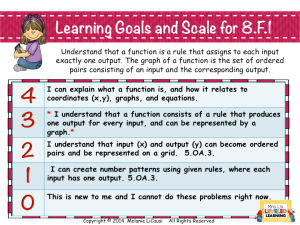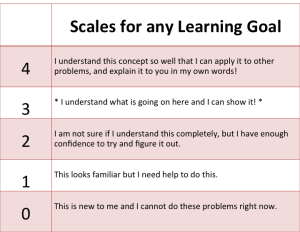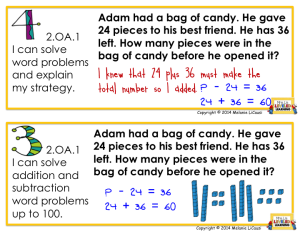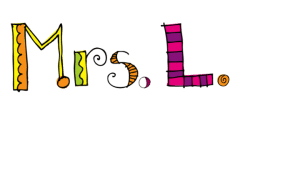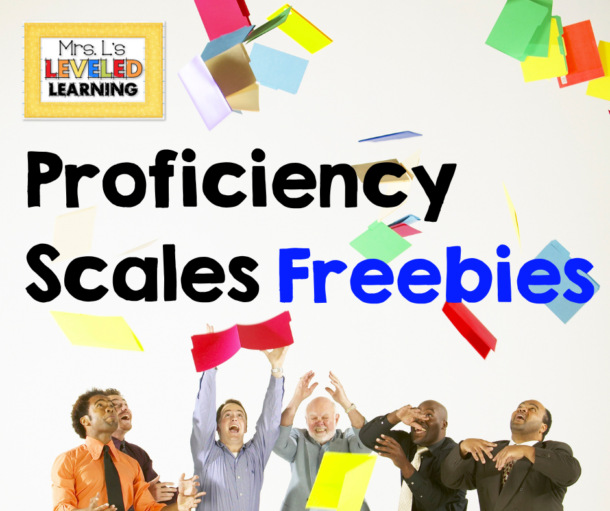Is it just me, or is it a little bit time-consuming to create unique Marzano scales?
What I find most difficult is deciding what content or sub-goal should be at each level under the primary goal. When I am developing assessments, I usually define each sub-goal as a sub-skill or previous grade level skill that they would’ve needed to master first. In The Art and Science of Teaching:A comprehensive Framework for Effective Instruction, Marzano talks about identifying the difference between activities and learning goals. It’s easy to get confused and difficult to think of what to focus on without some examples.
1. Choose Learning Goals strategically (bigger is better). Small goals are really hard to break down and you struggle to cover them all! I chose to focus on the standards because that is ultimately everyone’s goal!
2. Make them specific! Marzano & Haystead’s research cites that implementing scales can produce amazing gains in student learning, but they have to be done a certain way or you won’t see the results. General scales are fine to start with , and can help younger children to get used to the process, but they just don’t align to the research suggestions for making an effective Marzano scale. I liked the ease of using a general scale, but felt like it wasn’t enough for my students to be clear about how much they knew.
3. Choose an approach – Is your Learning Goal focused on content or cognitive skills???
This is important! If it’s focused on Content think NOUNS. What previous knowledge, maybe from other grade levels, would my kids need to know (or should have learned in previous years) to help them take this next step? This might be vocab, concepts, images and associations.
If it is focused on Cognitive skills think VERBS. What are my students doing mentally when they attempt this task? This is where the Blooms or Marzano Taxonomies can come in handy. These examples were found online and cited below. You can see the four levels of skills highlighted. This is really useful in deciding what tasks to assign to each level (1-4) of a scale.
4. Give Students Examples of each level! This helps them with the process of becoming self-aware. Students make progress because they learn to compare their skills with what’s expected and can see the next step. The posters give students a visual reminder of the scale for each standard. I created assessments to help define each level for my students. I have finished grades 3-8, and am currently working on 1st-2nd grade scales and resources. Visit Mrs. L’s Leveled Learning and click the “Follow Me” star to receive notices when new products are published.
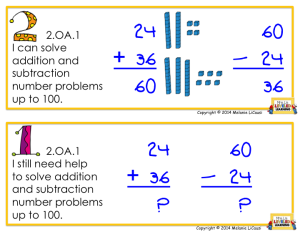 5. Finally, TEST THEM!!! When I first wrote my Marzano scales for math, I was teaching multi-age gifted and advanced math class at two Title I schools. Yes, they were all smart kids, but whoa! They had very different strengths and degrees of “smartness.” I created Assessments to objectively rate them on each scale. I put them in small groups to do different standards so I could test them all at once instead taking all year to get through them. It was insightful because the kids pointed out things that were unclear or illogical in my sequencing. It’s inevitable that you will be making some assumptions about what you think they should know or understand at each level. Sometimes kids will show mastery of your level 3 and not levels 1 or 2 because of the way you organized the tasks. give yourself time to do some research, and make a quality product that you can use every year. It will only make your job easier in the long run!
5. Finally, TEST THEM!!! When I first wrote my Marzano scales for math, I was teaching multi-age gifted and advanced math class at two Title I schools. Yes, they were all smart kids, but whoa! They had very different strengths and degrees of “smartness.” I created Assessments to objectively rate them on each scale. I put them in small groups to do different standards so I could test them all at once instead taking all year to get through them. It was insightful because the kids pointed out things that were unclear or illogical in my sequencing. It’s inevitable that you will be making some assumptions about what you think they should know or understand at each level. Sometimes kids will show mastery of your level 3 and not levels 1 or 2 because of the way you organized the tasks. give yourself time to do some research, and make a quality product that you can use every year. It will only make your job easier in the long run!
The following article gives a 5-step process to create your own Marzano scales for any learning goal you choose. This might be helpful if you’re just starting out and trying to understand what each scale means.
5 Steps to Creating Successful Common Core Scales for Student Learning – Learning Sciences Marzano Center
Here’s a sample page of instructions from Mrs. L’s Guide to Marzano Scales: Create, Present, Assess, Track and Share Student Progress with Scales.
For the complete and in-depth 30-page guide to Implementing scales in your classroom, visit MY STORE on TpT (tab above) or “Follow by Email” in the menu bar on the right and get a free copy sent to your inbox.
Here are some other resources I used to create my math assessments:
CC Math Standards (previous and subsequent grade levels) (or ELA)
AZ with examples (previous and subsequent grade levels) These have EXAMPLES of problems for each standard!
Progression of Standards This may help you to connect the important concepts from one grade level to the next.
If you’re interested in finding some examples of Marzano scales already done for Common Core Math; visit Mrs. L’s Leveled Learning on teacherspayteachers.com, or visit my Pinterest Board Learning Goals and Scales inspired by Marzano’s Research.
Thanks for stopping by!

